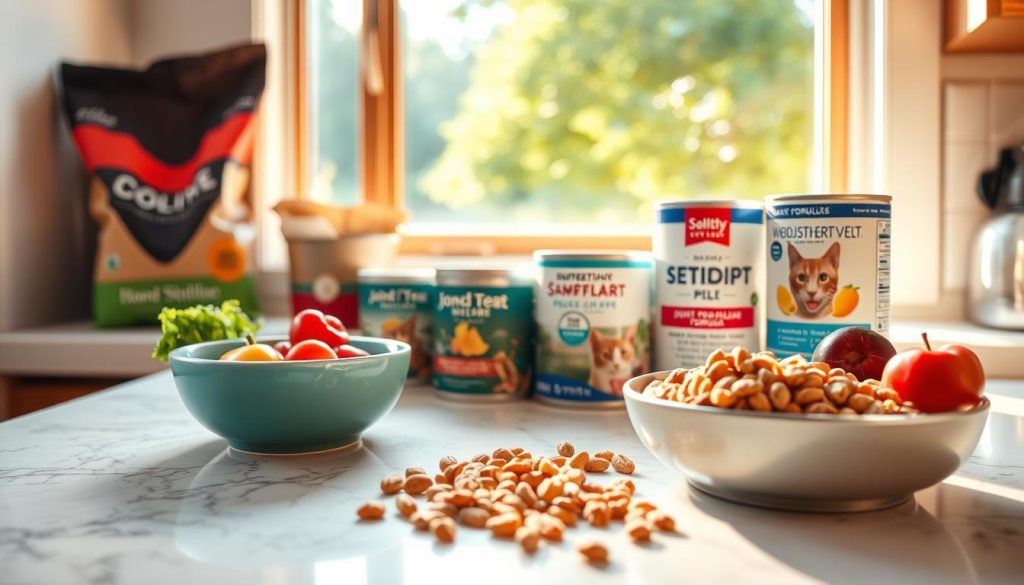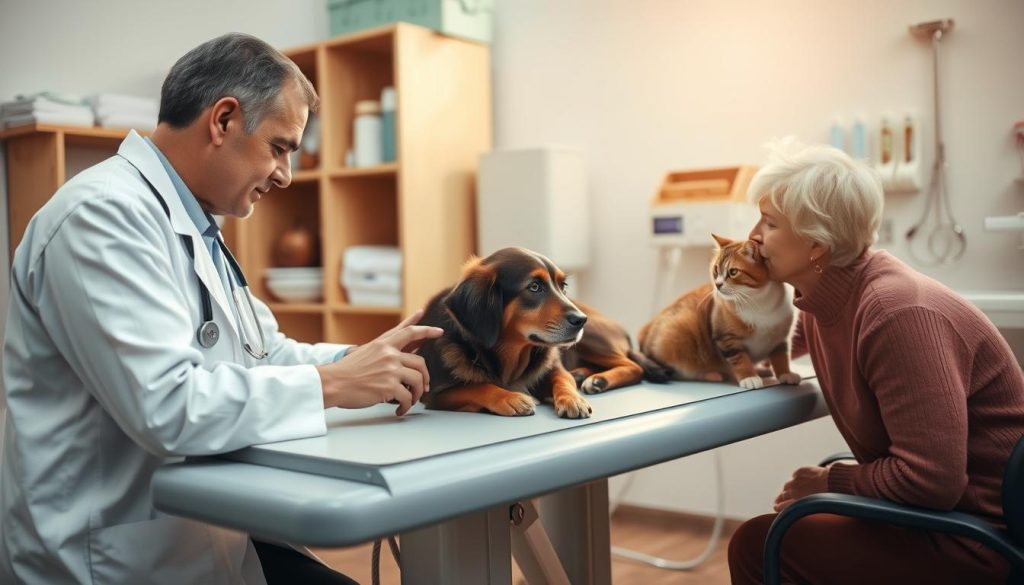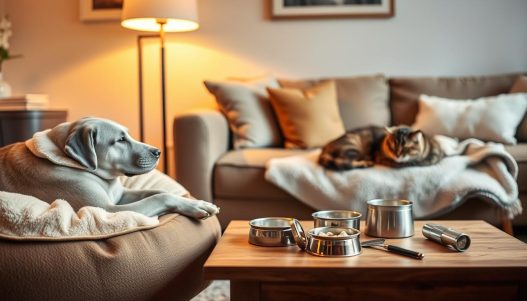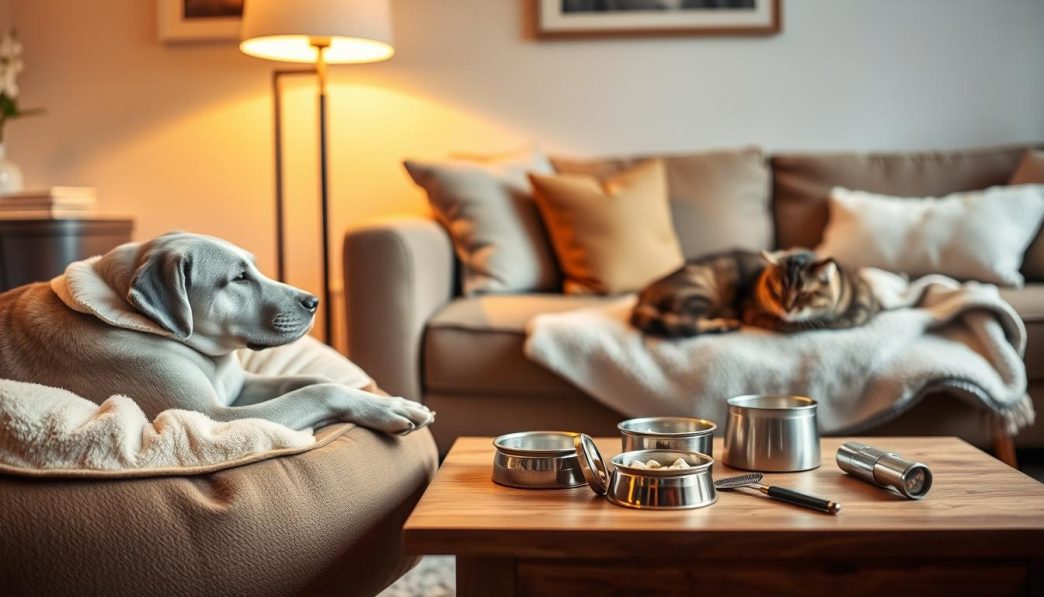As our beloved older dogs and older cats age, their needs change, and it’s crucial for pet owners to understand these changes to provide the best possible care.
Nutrition, exercise, and regular health checks become even more vital as pets grow older. Creating a comfortable living environment is also essential to ensure their golden years are happy and healthy.
Providing the right senior pet care involves a range of aspects, from adjusting their diet to accommodate aging digestive systems, to modifying exercise routines to suit their energy levels.
Key Takeaways
- Adjust nutrition for aging pets
- Modify exercise routines
- Regular health checks are crucial
- Create a comfortable living environment
- Understand the changing needs of older pets
Understanding the Aging Process in Pets
Pets, like humans, undergo significant changes as they age, and recognizing these changes is key to maintaining their health and comfort. The aging process in pets is influenced by factors such as breed, size, and overall health.
When Is a Pet Considered “Senior”?
The age at which a pet is considered senior varies by species and breed. Generally, dogs are considered senior between the ages of 7 to 10, while cats are considered senior around the age of 10 to 12. Larger dog breeds tend to have shorter lifespans and are considered senior earlier, often around 5 to 7 years.
Common Age-Related Changes in Dogs
As dogs age, they may experience a range of changes, including decreased mobility, weight gain or loss, and changes in coat condition. Older dogs may also develop age-related health issues such as arthritis, dental disease, and cognitive dysfunction.
| Age-Related Change | Description |
|---|---|
| Decreased Mobility | Reduced ability to move or perform physical activities |
| Weight Changes | Gain or loss of weight due to changes in metabolism or activity level |
| Coat Condition Changes | Changes in the texture, color, or health of the coat |
Common Age-Related Changes in Cats
Cats also undergo significant changes as they age. Common age-related changes include weight loss, decreased grooming, and changes in sleep patterns. Older cats may develop health issues such as kidney disease, hyperthyroidism, and arthritis.
“As our pets age, it’s essential to adjust their care to meet their changing needs, ensuring they remain comfortable and healthy.”
Understanding these changes and adapting care accordingly is crucial for maintaining the quality of life for senior pets.
Signs Your Pet Is Entering Their Senior Years
Recognizing the signs of aging in pets is vital for providing the best possible care for older dogs and cats. As pets age, they undergo various physical and behavioral changes that can signal they’re entering their senior years.
Physical Changes to Watch For
Physical changes are often the most noticeable signs of aging in pets. These can include weight gain or loss, decreased mobility, and changes in their coat condition. Older pets may also experience dental issues, such as tooth loss or gum disease, which can affect their overall health and comfort.
Behavioral Changes That Indicate Aging
Behavioral changes can be just as telling as physical changes. Older pets may exhibit increased anxiety, confusion, or changes in their sleep patterns. Some pets may become more vocal or clingy, while others may become more withdrawn.
When to Consult Your Veterinarian
If you notice any significant changes in your pet’s behavior or physical condition, it’s essential to consult with your veterinarian. They can help determine the cause of these changes and recommend appropriate care or treatment to ensure your pet remains comfortable and healthy.
By being aware of these signs and consulting with your veterinarian, you can help your older dog or cat enjoy a better quality of life in their senior years.
Senior Pet Care: Keeping Older Dogs and Cats Comfortable
Comfort is key when it comes to caring for older dogs and cats. As pets age, their needs change, and it’s essential to adapt their living environment to ensure they remain comfortable and happy.
Creating a Comfortable Living Environment
A comfortable living environment is vital for senior pets. This includes providing a quiet, stress-free space where they can rest without disturbance. Orthopedic beds can be particularly beneficial for older pets suffering from joint pain or arthritis.
Temperature and Bedding Considerations
Senior pets often have a harder time regulating their body temperature. Keeping your home at a comfortable temperature can help. Additionally, consider using heated beds or cooling pads to provide extra comfort. The bedding should be supportive and comfortable, reducing pressure on joints.
Accessibility Modifications for Your Home
Making accessibility modifications can significantly improve the quality of life for senior pets. This can include installing ramps for easier access to higher areas, such as beds or cars, and ensuring that food, water, and litter boxes are easily accessible. Minimizing the need for jumping or climbing stairs can also reduce strain on older pets.
By implementing these changes, you can create a more comfortable and accessible living environment for your senior pet, enhancing their overall well-being and quality of life.
Nutrition Needs for Senior Pets
Proper nutrition is crucial for maintaining the health and comfort of older dogs and cats. As pets age, their nutritional needs change, requiring adjustments in their diet to ensure they receive the necessary nutrients for optimal health.
Dietary Changes for Aging Dogs
Aging dogs often require fewer calories due to decreased activity levels, but they may need more of certain nutrients like protein and joint support supplements. High-quality senior dog food should be rich in essential nutrients and easy to digest.
Dietary Changes for Aging Cats
Senior cats have different nutritional needs as well. They may require more protein and fewer carbohydrates. Additionally, older cats may benefit from foods that support urinary health and are formulated to reduce the risk of kidney disease.
Supplements That Benefit Senior Pets
Supplements can play a beneficial role in the diet of senior pets. Common supplements include omega-3 fatty acids for skin and coat health, glucosamine and chondroitin for joint health, and antioxidants to combat aging.
Maintaining Proper Hydration
Ensuring senior pets stay hydrated is crucial. Encourage water intake by providing multiple water sources and considering the addition of wet food to their diet.
| Nutritional Element | Benefit for Senior Pets | Food Sources |
|---|---|---|
| Protein | Maintains muscle mass | Meat, fish, eggs |
| Omega-3 Fatty Acids | Supports skin and coat health | Fish oil, flaxseed |
| Glucosamine and Chondroitin | Supports joint health | Supplements, certain dog foods |

Exercise and Activity for Older Pets
Exercise remains a crucial aspect of pet care, even as dogs and cats enter their senior years. Regular physical activity helps maintain their physical health, while mental stimulation is essential for preventing cognitive decline.
Appropriate Exercise for Senior Dogs
For senior dogs, exercise should be gentle and low-impact to avoid putting excessive strain on their joints. Short, frequent walks are an excellent way to keep them active without overexertion. Swimming is another beneficial activity, as it’s easy on the joints while providing a good workout.
Keeping Senior Cats Active
Senior cats also benefit from regular activity, although their exercise needs are generally less intense than those of dogs. Interactive toys and gentle play can encourage them to move around and stay engaged. Cat trees or climbing structures can also help maintain their flexibility and strength.
Mental Stimulation for Aging Pets
Mental stimulation is just as important as physical exercise for aging pets. Puzzle toys filled with treats challenge their problem-solving skills and keep their minds active. Regular interaction and training sessions, even if simple, can also provide mental stimulation.
Adapting Activities to Mobility Limitations
As pets age, they may develop mobility issues that require adapting their exercise routines. For pets with limited mobility, gentle stretching and passive range-of-motion exercises can be beneficial. It’s essential to consult with a veterinarian to develop an exercise plan tailored to your pet’s specific needs and limitations.
Common Health Issues in Senior Pets
As pets age, they become more susceptible to various health issues that can significantly impact their quality of life. Understanding these common health problems is crucial for providing the best possible care for your senior pet.
Arthritis and Joint Problems
Arthritis is a common condition in older pets, causing pain and stiffness in the joints. Maintaining a healthy weight and providing gentle exercise can help alleviate symptoms. According to experts, “arthritis is one of the most common causes of chronic pain in older pets,” highlighting the need for effective management strategies.
Dental Disease
Dental disease is a significant health issue in senior pets, often leading to pain, infection, and other systemic health problems if left untreated. Regular dental check-ups and proper oral hygiene are essential for preventing and managing dental disease.
Vision and Hearing Loss
As pets age, they may experience vision and hearing loss, which can affect their interaction with the environment and their owners. Adapting your home environment to be more pet-friendly can help mitigate the impact of sensory loss.
Cognitive Dysfunction
Cognitive dysfunction in senior pets can manifest as confusion, disorientation, and changes in behavior. Providing mental stimulation and maintaining a consistent routine can help manage cognitive decline.
Weight Management Challenges
Weight management becomes increasingly challenging as pets age, due to factors like reduced mobility and metabolic changes. Monitoring food intake and ensuring adequate physical activity are crucial for maintaining a healthy weight.
By being aware of these common health issues and working closely with your veterinarian, you can help ensure your senior pet enjoys a comfortable and fulfilling life.
Preventative Healthcare for Senior Pets
Preventative healthcare is essential for senior pets to detect health issues early and manage them effectively. As pets age, their susceptibility to various health problems increases, making regular preventative care crucial.
Recommended Veterinary Check-up Schedule
Senior pets should visit the veterinarian at least twice a year for a comprehensive check-up. These visits help in early detection of potential health issues and ensure timely intervention.
Screening Tests for Early Detection
Regular screening tests, such as blood work and urinalysis, are vital for identifying health problems in their initial stages. These tests can help detect conditions like kidney disease, diabetes, and liver disease.
Vaccinations for Older Pets
While the vaccination needs of senior pets may differ from those of younger animals, they still require protection against certain diseases. Consult with your veterinarian to determine the most appropriate vaccination schedule.
At-Home Health Monitoring Tips
Pet owners can play a significant role in monitoring their senior pet’s health at home. Keep an eye out for changes in appetite, water consumption, and behavior, and report any concerns to your veterinarian.
| Health Monitoring Aspect | What to Look For | Action to Take |
|---|---|---|
| Appetite Changes | Decrease or increase in food consumption | Consult veterinarian if changes persist |
| Water Consumption | Increased or decreased water intake | Monitor and report changes to veterinarian |
| Behavioral Changes | Changes in activity level, confusion, or anxiety | Discuss with veterinarian to rule out underlying health issues |
Managing Chronic Conditions in Aging Pets
Managing chronic conditions in aging pets is crucial for maintaining their quality of life. As pets age, they are more likely to develop conditions such as diabetes, kidney disease, and heart disease, which require careful management.

Diabetes Management
Diabetes in pets, particularly dogs and cats, requires a comprehensive management plan. This includes regular monitoring of blood glucose levels, dietary adjustments, and insulin administration. Consistency is key in managing diabetes effectively.
- Monitor blood glucose levels regularly
- Adjust diet according to veterinary recommendations
- Administer insulin as prescribed
Kidney Disease Care
Kidney disease is common in older pets and requires a multi-faceted approach. This includes dietary changes, ensuring adequate hydration, and regular veterinary check-ups. A balanced diet that is easy on the kidneys is crucial.
- Feed a kidney-friendly diet
- Ensure access to fresh water at all times
- Schedule regular check-ups with your veterinarian
Heart Disease Considerations
Heart disease in aging pets can manifest in various forms, including congestive heart failure. Management involves medication, dietary adjustments, and monitoring for signs of heart failure. Early detection is critical.
Medication Administration Techniques
Administering medication to pets can be challenging. Techniques such as hiding medication in treats or using pill dispensers can make the process easier. It’s essential to follow the veterinarian’s instructions carefully.
By understanding and managing chronic conditions effectively, pet owners can significantly improve the quality of life for their aging pets.
Pain Management for Senior Pets
Effective pain management is crucial for improving the quality of life in older pets. As pets age, they are more likely to experience pain due to various conditions such as arthritis, dental disease, or other chronic health issues.
Recognizing Signs of Pain
Recognizing pain in senior pets can be challenging, as they often hide discomfort. Common signs include changes in behavior, such as increased irritability or withdrawal, changes in appetite, and alterations in mobility or gait.
Medication Options
Several medication options are available for managing pain in senior pets. Nonsteroidal anti-inflammatory drugs (NSAIDs) are commonly used to treat pain and inflammation. In some cases, opioids may be prescribed for more severe pain.
Alternative Therapies
Alternative therapies can complement traditional medication. These include acupuncture, physical therapy, and laser therapy, which can help reduce pain and improve mobility.
Creating a Pain Management Plan
Creating a comprehensive pain management plan involves working closely with your veterinarian. This plan should be tailored to your pet’s specific needs and may include a combination of medications, alternative therapies, and lifestyle adjustments.
| Therapy Type | Description | Benefits |
|---|---|---|
| Acupuncture | Involves inserting fine needles into specific points on the body | Pain relief, improved mobility |
| Physical Therapy | Exercises and techniques to improve mobility and strength | Enhanced mobility, reduced pain |
| Laser Therapy | Uses light to stimulate healing and reduce pain | Pain relief, accelerated healing |
Grooming and Hygiene for Older Pets
Grooming is an essential aspect of caring for senior pets, impacting their overall well-being. As pets age, their grooming needs change, requiring more attention and care to maintain their health and comfort.
Special Grooming Needs for Senior Dogs
Senior dogs often require more frequent grooming due to decreased mobility and potential weight gain. Regular brushing helps prevent matting and reduces shedding. Additionally, older dogs may need more frequent nail trimming and ear cleaning due to reduced activity levels.
Special Grooming Needs for Senior Cats
Senior cats also benefit from regular grooming, particularly if they have arthritis or other mobility issues. Gentle brushing can help reduce hairballs and improve circulation. Older cats may also require more frequent litter box cleaning due to potential incontinence issues.
Mobility Assistance for Grooming
Many older pets benefit from mobility assistance during grooming. This can include supporting their joints or using ramps to help them access grooming areas. Providing a comfortable and stable environment during grooming can significantly reduce stress and discomfort.
Managing Incontinence Issues
Incontinence is a common issue in older pets, particularly those with medical conditions or age-related decline. Managing incontinence involves regular cleaning, using protective garments, and potentially adjusting their diet or medication. Consult with a veterinarian to develop a plan tailored to your pet’s needs.
| Grooming Aspect | Senior Dogs | Senior Cats |
|---|---|---|
| Brushing Frequency | Regular brushing to prevent matting | Gentle brushing to reduce hairballs |
| Nail Trimming | More frequent trimming due to reduced activity | Regular trimming to prevent overgrowth |
| Incontinence Management | Use protective garments and adjust diet or medication | Regular litter box cleaning and potential protective garments |
Quality of Life Considerations
The quality of life for senior pets is a critical consideration that requires careful assessment and decision-making. As pets age, their needs change, and their quality of life can be affected by various factors, including health conditions, mobility, and cognitive function.
Assessing Your Pet’s Quality of Life
Assessing your pet’s quality of life involves evaluating their overall well-being, including their physical and emotional health. Factors to consider include their ability to perform daily activities, manage pain, and interact with their environment and family members.
End-of-Life Care Options
When a pet’s quality of life is severely compromised, end-of-life care options must be considered. This can include palliative care to manage pain and discomfort, as well as euthanasia as a final option to prevent suffering.
Making Difficult Decisions
Making decisions about a pet’s end-of-life care is challenging. It requires careful consideration of the pet’s quality of life, consultation with a veterinarian, and a compassionate understanding of the pet’s needs and condition.
Coping with Grief and Loss
Losing a pet is a significant loss for many owners. Coping with grief involves acknowledging the emotional impact of the loss, seeking support from family, friends, or professional counselors, and finding ways to honor the memory of the pet.
| Quality of Life Factors | Indicators of Good Quality | Indicators of Poor Quality |
|---|---|---|
| Pain Management | Minimal or no pain | Chronic or unmanaged pain |
| Mobility | Ability to move comfortably | Difficulty walking or standing |
| Appetite and Hydration | Eats and drinks normally | Loss of appetite or dehydration |
Conclusion
As pets age, their needs change, and providing the right care becomes crucial to ensuring their comfort and quality of life. This article has explored the essential aspects of senior pet care, from understanding the aging process to managing chronic health issues.
Caring for older pets requires attention to their changing nutritional needs, exercise requirements, and health issues. Regular veterinary check-ups, a comfortable living environment, and adapting activities to their mobility limitations are vital components of senior pet care.
By recognizing the signs of aging and providing appropriate care, pet owners can significantly improve the quality of life for their older dogs and cats. This senior pet care summary highlights the importance of comprehensive care, including pain management, grooming, and quality of life considerations.
Ultimately, caring for older pets is a rewarding experience that requires dedication, patience, and compassion. By following the guidelines outlined in this article, pet owners can provide their senior pets with the care and comfort they need to thrive in their golden years.






